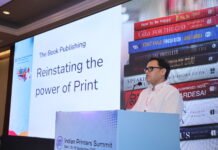According to a report recently published in The Times of India, British sales of eBooks are waning, suggesting that readers may be suffering from screen fatigue. The same report further reiterates that Britain’s publishing industry had a record-breaking year in 2016, with sales of book and journals recording their fastest year-on-year growth in a decade to reach EUR 5.7 billion. However, eBook sales fell 3%, continuing a trend first visible in 2015.
“For many years we have been discussing that the number of physical book readers is decreasing. In fact, printing itself has been visibly decaying. But in book publishing, the number of titles are increasing like never before although the print runs havedeclined. So, technically speaking, the increased number of book titles are countervailing the decreased print run in a befitting way,” says MN Pandey of Delhi-based Avantika Printers.
“Whether the reading habits of people are on the rise or not, the number of book titles is definitely on the upswing. Print runs are going down as publishers fear taking risks; they just want to secure the order rather than printing higher volumes, storing books in the warehouse and waiting for sales,” says Subhasis Ganguly, publishing veteran and a consultant in publishing operations.
Ganguly says, “Digital is bound to play a major role in book publishing. People are realizing there are discomforts associated with eBook reading. Those who were ardent fans of eBooks are now coming back to the traditional format; and with a plethora of new writers coming up today, digital as a solution is the only viable way to cater to short-run book production. The digital technology has even opened the window for writers to print a single copy and approach a publisher with it in hand.”
In the last three years, much restructuring has taken place in the publishing industry. “As a result, the production department is not restricted to its traditional job but has evolved into a print operation. It is now responsible for giving information on sales margins and also to take care of stock holding. Hence, the publisher’s production department allows only that number of books to be printed which do not pose any risk to the publisher. By following this rule, I spend less, I sell everything and I am not left with any backlog. Although my digital printing cost is higher than offset, it is beneficial nevertheless. Publishers who are able to understand this are gradually moving towards digital,” says Ganguly.

















